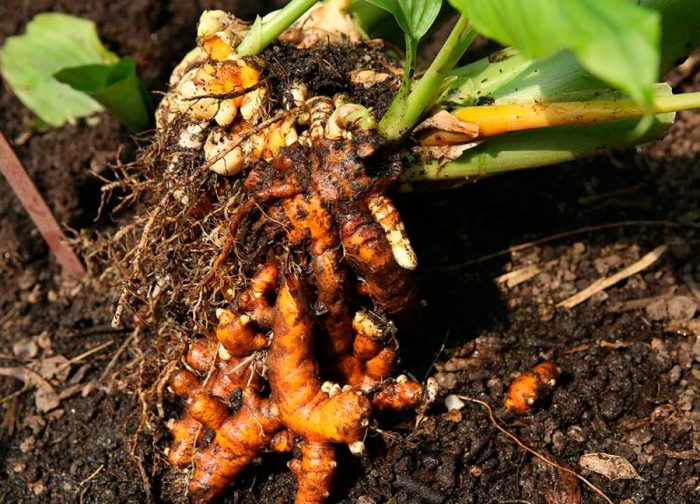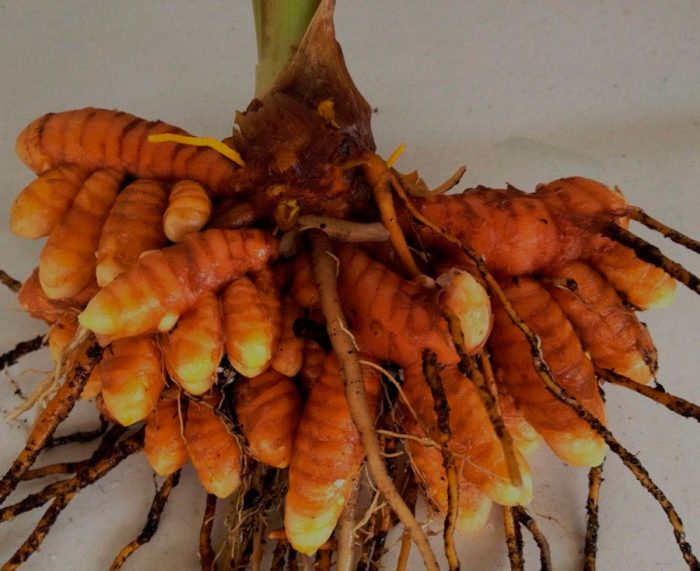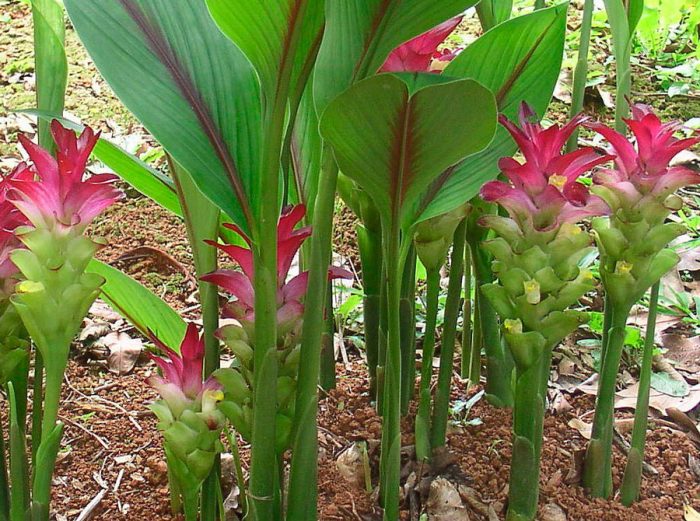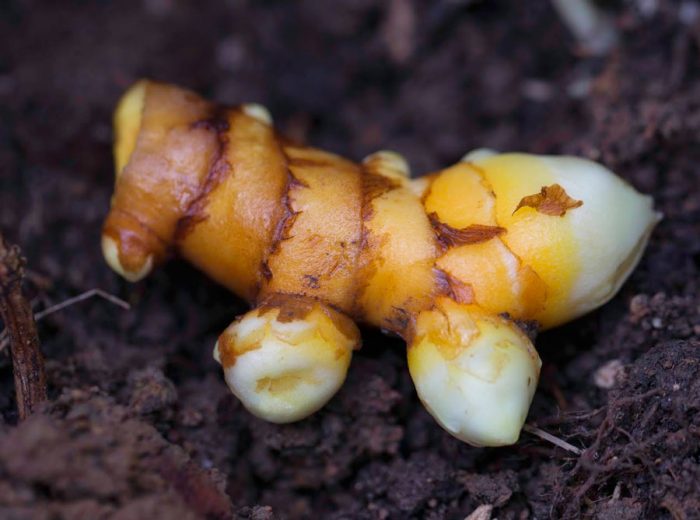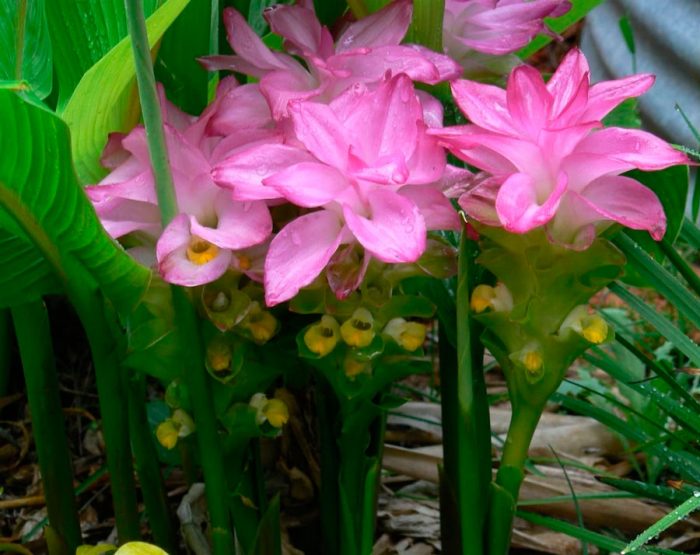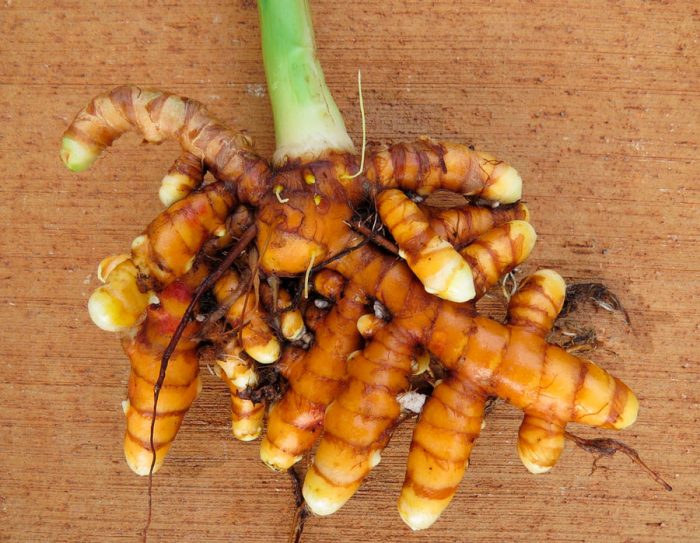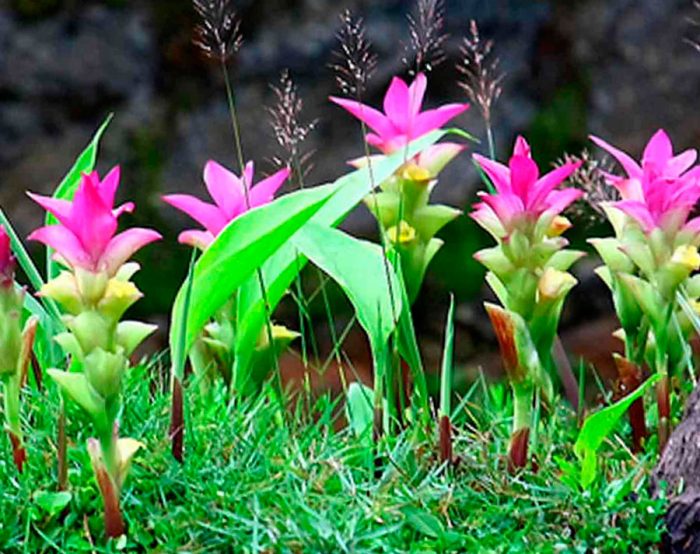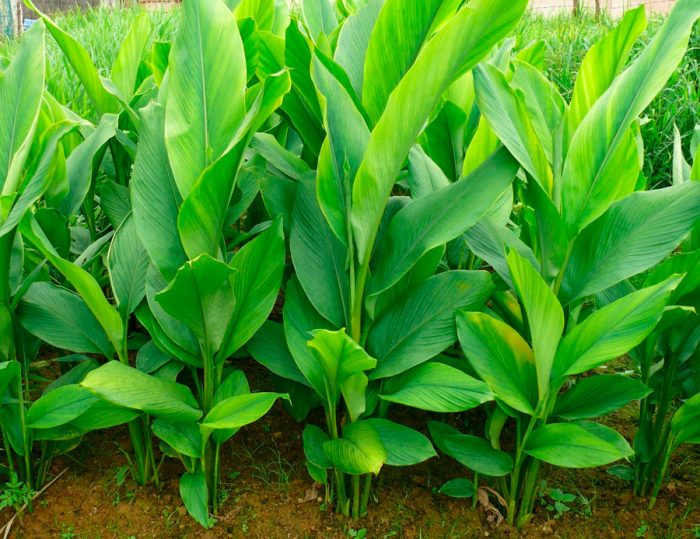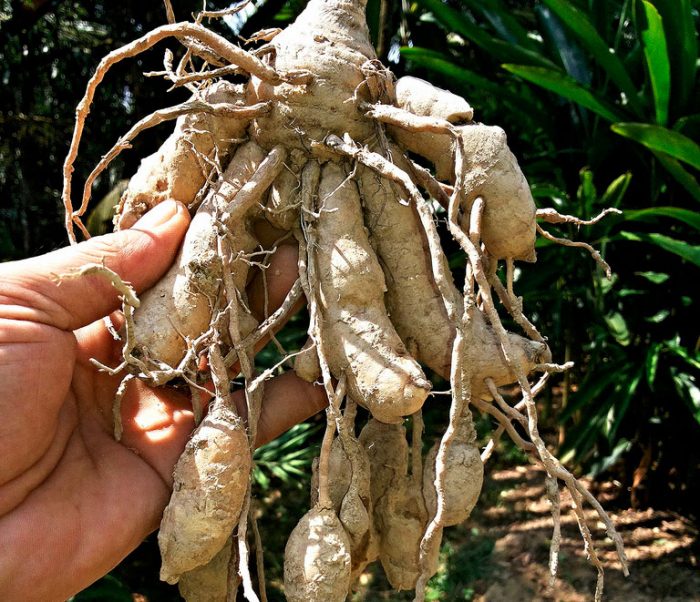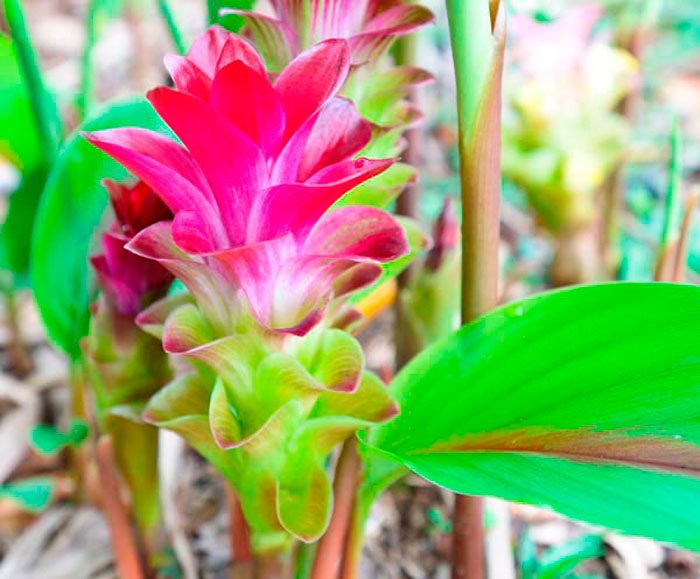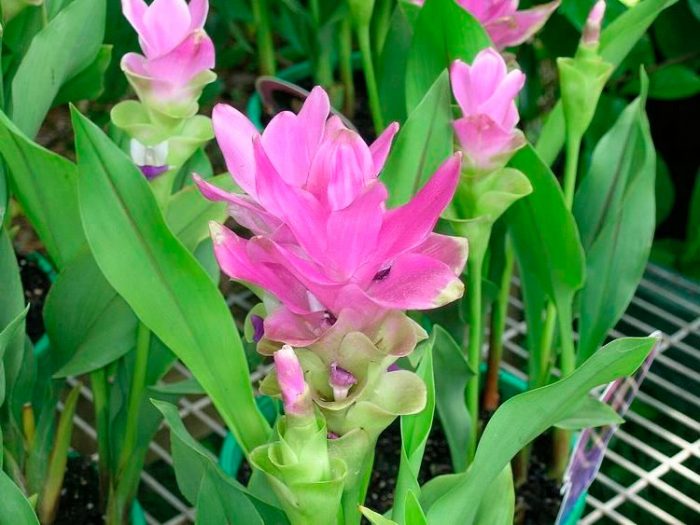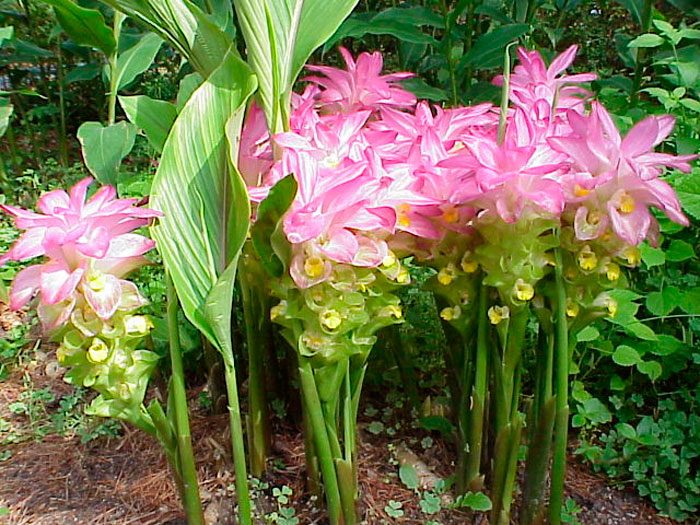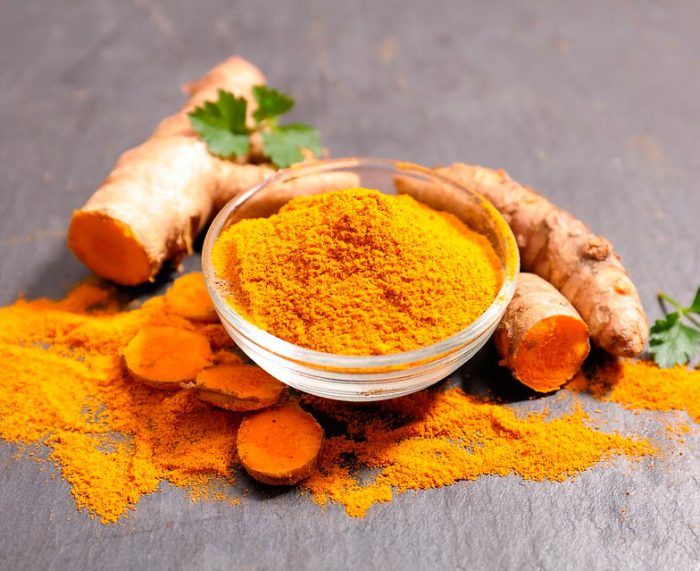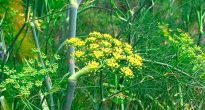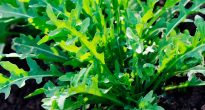The monocotyledonous plant turmeric (Curcuma) is a member of the Ginger family. The rhizome contains yellow dyes, as well as essential oils, in this regard, it is grown as a medicinal and spicy plant. The most commonly cultivated type of turmeric is homemade, or turmeric long, or turmeric, or cultural turmeric, or yellow turmeric (Curcuma longa). Powder is made from the dried rhizome, which is used as a spice, called "turmeric". Under natural conditions, such a plant can be found only in India; today it is the leader in the export of spices made from turmeric rhizomes. In gardens, this plant has been cultivated since the nineties of the 19th century.
Content
Brief description of cultivation
- Bloom... It starts in July and ends in October.
- Landing... Parts of the rhizome are planted in open soil from March to April.
- Illumination... Bright sunlight or shaded area.
- Priming... Rich sandy or clayey soil.
- Watering... It is necessary to water abundantly and often, while the water consumption directly depends on the composition of the soil.
- Fertilizer... During budding, at the beginning of flowering and half a month after the turmeric has faded, a complex mineral fertilizer for decorative deciduous plants is used for this, while only ½ part of the dosage indicated in the instructions should be applied.
- Reproduction... By seed method and parts of the rhizome.
- Harmful insects... Spider mites.
- Diseases... Leaf spot and root rot.
- Properties... This is a fairly popular medicinal and spice plant. It has antiviral, antimicrobial, immunomodulatory, tonic, warming, anthelmintic, antiseptic, anti-inflammatory, regenerating, sedative and blood-accelerating effect.
Features of turmeric
Turmeric long is a herbaceous perennial plant that has a height of about 0.9 m. Oval leaf plates alternate in two rows. The rounded tuberous rhizome reaches 40 mm in diameter, it is painted in a grayish-yellow color and has scars from the foliage of a ring shape.Many thin roots extend from the rhizome, with some of them forming small tubers at the tips. From the apical bud of the rhizome, the aerial part of the bush grows, which includes several sheathic leaf plates with long petioles and a peduncle, the height of which is about 0.3 m, while it is densely seated with green stipules with paler tips. In those stipules that are in the middle part of the peduncle, tubular, three-lobed, fragrant flowers of yellow color grow in the axils, they have a wide lip and a slightly irregular limb. All tissues of this plant contain valuable essential oils.
Growing turmeric outdoors
Planting turmeric
Turmeric is cultivated both in open soil and in indoor conditions, as a result you will get a useful spice, and you can also admire the spectacular and fragrant flowers of this plant. But it should be borne in mind that from the moment the seedlings appear, about 9 months should pass before harvesting, in this regard, turmeric is grown in open soil only in the southern regions, where autumn comes late, and spring is warm and early. In mid-latitudes and in areas with colder climates, such a crop is grown in indoor conditions.
Plots in partial shade or well-lit by the sun are perfect for growing this plant, while the soil should be rich in clay. However, turmeric also grows well in sandy soil. Before proceeding with planting, the site must be prepared. To do this, they dig it to a depth of at least 20 centimeters, and then loosen the soil. The depth of the planting pits should be about 15 centimeters, and the distance between them is from 15 to 20 centimeters, 2 or 3 rhizome segments should be placed in them. On all parts of the rhizome, 1-2 buds should be present, while placing them in the holes when planting should be upward with these buds. Then, the pits are filled in, while above each rhizome, the thickness of the soil layer should be at least 20 mm. The planted planting material needs watering. Planting this plant in open soil is carried out in March or April.


Watch this video on YouTube
Turmeric Garden Care
Since turmeric is a moisture-loving plant, it is very important to provide it with proper and timely watering. The frequency and abundance of irrigation is influenced by weather conditions, climate, and also the composition of the soil in the area where this crop is grown. Water such a plant with warm water, which was previously heated in the sun.
For feeding, a complex mineral fertilizer for ornamental deciduous plants is used, which should contain a large amount of phosphorus, while it should be borne in mind that the nutrient solution should have a concentration that is half that indicated on the package. Bushes are fed during the formation of buds, as soon as they bloom, and half a month after the end of flowering.
Otherwise, caring for such a plant is quite simple. In order for the bushes to be neat and effective, it is necessary to cut off the flowers that have begun to fade in time. After the rain has passed or the bed is watered, it is imperative to loosen the soil surface between the plants, while pulling out all the weeds.
Harvesting turmeric
Turmeric rhizomes are removed from the soil before the cold sets in, or rather, in October or November, while the aboveground part of the bush should begin to fade. At the rhizome, the upper part is cut off and the remains of soil and small roots are removed from it. Then it is immersed in boiling water for 60 seconds, thanks to this, the release of the coloring matter from special cells will begin, it is this that gives the rhizome a yellow color. Then the raw materials are laid out to dry in a place with good ventilation, it will be ready after 7-15 days.When the rhizomes are ready, their shape will resemble a horn.
How to store turmeric
For storage, raw materials are placed in containers or boxes filled with moistened sand, while the air temperature should be from 10 to 12 degrees. The crushed raw materials are placed in a glass jar for storage, which is tightly closed with a lid and removed to a cool and dark place, where it will be stored for no longer than three years. It must be remembered that such a spice is capable of absorbing foreign odors.
Types and varieties of turmeric with photos and names
Only a few types of turmeric are cultivated. Each of these types has its own purpose.
Aromatic turmeric (Curcuma aromatica), or Indian saffron
This perennial plant can sometimes be found in South Asia, but it is most widespread in the warm massifs of the eastern regions of the Himalayas and in India. The height of the bush is about 100 centimeters. Fragrant fleshy rhizomes can be elliptical or narrow, from the inside they have a yellow color, fusiform tubers form on their thin roots. The length of the oblong leaf plates is about 0.6 m, and their width is up to 0.2 m, they have petioles, the shape of which is similar to leaves. The funnel-shaped flowers are hidden in spike-shaped inflorescences, which are 15 centimeters long and 8 centimeters wide. The length of the ovoid bracts is about 50 mm, they have a light green color, but at the top it becomes reddish-red. This type is very popular as a spicy plant, and in the confectionery industry it is valued higher than long turmeric.
Turmeric long (Curcuma longa), or turmeric, or yellow ginger
This species is a valuable spice, and it is also used as a medicinal plant and as a dye. This view is described in detail at the beginning of the article. It is good to know that long turmeric is definitely added to Indian curry during its preparation.
Round turmeric (Curcuma leucorrhiza)
In nature, this species can be found only in India. Elongated roots have an oblong shape. Narrow-lanceolate leaf plates have petioles. This species was named so because the shape of its flowers is round. In India, starch is made from the roots of such a plant. To do this, the roots extracted from the soil are ground with stone millstones or pounded in a mortar. After that, all the liquid is manually squeezed out of the resulting mass, which is filtered through the fabric. The mass itself is well dried and used as starch.
Turmeric zedoaria (Curcuma zedoaria)
In the wild, this species can be found in Indonesia and India. This turmeric is cultivated on the island of Java, India, South China and Thailand. The height of the bush can be up to 150 centimeters, but there are also higher specimens. The length of the leaf plates is about 0.8 m; on their surface, streaks of brownish-purple color are clearly visible, which extend from the median vein. The color of the bracts is deep pink. Even before the foliage grows, inflorescences are formed, consisting of fragrant flowers, while they move away from the rhizome. The root shape is pear-shaped, and in size it is similar to a pigeon's egg. It has a camphor smell and a bitter pungent taste; it is used in confectionery and in the preparation of liqueur.
Small turmeric (Curcuma exigua)
The height of the bush is about 0.8 m. The multi-branched root rhizomes are yellow from the inside and fleshy. The tubers are formed at the ends of the roots. Lanceolate leaf plates of green-purple color along the median vein have a pale red stripe, and they also have petioles reaching 50–80 mm in length. The length of the leaves is about 20 centimeters, and their width is up to 7 centimeters. The yellow flowers are elliptical. The tops of the oval-elliptical bracts are violet-white. Corolla color is light purple. The plant blooms in August – October. This type is cultivated only as an ornamental plant.
Sumatran turmeric (Curcuma sumatrana)
This plant is endemic to the island of Sumatra.It was first described more than a century and a half ago. A very spectacular bush outwardly similar to homemade turmeric. This species is endangered as a result of a sharp reduction in the area of its range. This plant is cultivated only as an ornamental one.
Turmeric properties: benefits and harms
Benefits of turmeric
Turmeric is rich in essential oils and starch, and the polyphenol curcumin gives it its characteristic yellow color. This plant also contains lipids, proteins, dietary fiber, carbohydrates, B vitamins (choline, pyridoxine, riboflavin, thiamine), vitamins E, PP, C, K, betaine, mineral salts of phosphorus, magnesium, calcium, sodium, manganese , iron, zinc, sulfur and copper, omega-6 and omega-3 fatty acids, phytosterols and monoterpenes. As a result, turmeric has antiviral, antimicrobial, immunomodulatory, tonic, warming, anthelmintic, antiseptic, anti-inflammatory, regenerative, sedative and blood-warming effect.
This plant is used for cuts and burns because it is a natural antiseptic. Turmeric helps to stop the development of melanoma and the destruction of the formed cells of this formation. It can also help slow the progression of Alzheimer's disease and dissolve amyloid plaque deposits in the brain. Turmeric helps prevent the formation of metastases of various forms of cancer. With the combined use of turmeric and cauliflower, you can delay the development of a malignant tumor of the prostate. The use of this plant during chemotherapy helps to enhance the healing effect and reduce unwanted side effects from toxic medications. For the liver, turmeric is a natural detoxifier, it participates in the metabolism of fats, and even helps to get rid of extra pounds faster.
This culture is considered to be a powerful antidepressant and is widely used in Chinese alternative medicine. It is successfully used in the treatment of diabetes mellitus, including rheumatoid. Turmeric helps to quickly restore the epidermis in inflammatory diseases of the skin, eczema, boils and psoriasis. To quickly get rid of the burn, it is recommended to use a paste that contains aloe vera juice and turmeric. Experts advise using such a plant for colds, sore throat and severe cough, migraines, atherosclerosis, chronic diarrhea, ulcerative colitis and gallstone disease.
The ability of turmeric to get rid of extra pounds is also very popular. How to take it correctly in this case? Combine 1 tbsp. bio-kefir and ½ tsp. turmeric, the mixture should be infused for 15-30 minutes, it is drunk just before bedtime. The duration of the course is from 1 to 2 months.


Watch this video on YouTube
Contraindications
Since this plant has a powerful effect on the body, before you start taking it, you should definitely consult with your doctor, especially if you are already using any medicine. Turmeric is definitely contraindicated for a person with individual intolerance, and even if the bile ducts are clogged or there are stones larger than 0.5 cm in the gallbladder.Often, experts do not advise children under 5 years of age and women during pregnancy to use this plant. No other contraindications have been established to date.

